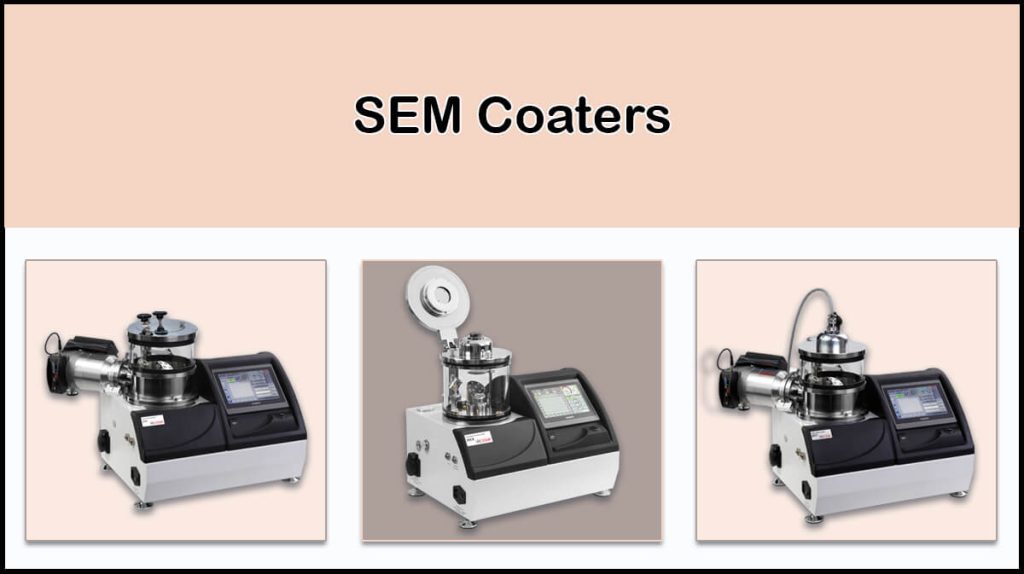Why SEM Samples Should be Coated?
Scanning electron microscopy (SEM) is a versatile technique for imaging micro or nano-sized structures employing a beam of energetic electrons. The samples to be studied by SEM imaging should be conductive to prevent damage to the sample by electrons build-up on its surface, resulting in charging and heating it up.
Therefore, coating the scanning electron microscope samples’ surface with a thin conductive film is a crucial step in the SEM sample preparation procedure. This nanometer-sized conductive thin layer can be deposited through physical vapor deposition (PVD) methods, such as sputtering and thermal evaporation techniques, as in Vac Coat SEM coaters.
You can see Human Kidney, Poly Styrene, Leaf, and Fungus SEM sample images with Vac Coat DSR1 here.
Common Coating Techniques for SEM Sample Preparation
1- Sputtering for SEM Coaters: SEM Sputter Coaters
Sputtering deposition is a physical vapor deposition method in which high-energy plasma particles, ions, and electrons, eject the molecules/atoms from the target material surface, which are then accumulated on the substrate to form a thin layer of the target atoms (You can read about Vacuum Plasma Treatment hear).
Vac Coat ion sputtering coaters for SEM sample preparation work under low and high-vacuum conditions for deposition of oxidizing and non-oxidizing materials. Low vacuum magnetron SEM sputter coaters are suitable to produce the common gold coatings for scanning electron microscopy and also are the right choice for the deposition of other non-oxidizing metals such as platinum (pt). Vac Coat magnetron desk sputter coater DSR1 is an ideal choice when a low-vacuum scanning electron microscopy coating is required.
However, high vacuum turbo-pumped SEM coaters provide the proper conditions for the deposition of oxidizing metals, like tungsten, iridium, and chromium. Also, sputter coating for SEM samples at higher vacuum levels results in forming a layer with a finer grain size, which is ideal for FESEM imaging (Read more Effect of Base Pressure on Thin Film Grain Size in Sputtering here).
Vac Coat DST1-170 and DST1-300 with a small and large chamber, respectively, are capable of high-vacuum sputtering deposition of a wide range of materials and producing fine-grain-sized FESEM coatings.
2- Thermal Evaporation in SEM Coaters
Thermal evaporation of various conductive materials and deposition of the vaporized source on the sample is a well-known method for SEM sample coating. In this way, different sources like metals and carbon are resistively heated and vaporized to form a conductive coating on the SEM sample.
Sputtering of SEM Samples vs Thermal Evaporation
The deposition process in this method takes more time and requires high-vacuum conditions compared to the sputter coating of SEM samples, whereas a more uniform coating that can penetrate a porous sample is provided. DTE is a compact Vac Coat desktop high-vacuum deposition system with small chamber, respectively, suitable for thermal evaporation of different material sources.
3- Carbon Coating for Electron Microscopy: SEM Carbon Coaters
Carbon coating for SEM samples is another option for making a conductive layer over the insulating surfaces. Deposition of carbon results in an amorphous layer on the sample which is also perfect for EDX analysis.
TEM grids also need carbon layer deposition as a highly conductive layer with negligible imaging interference. Since different coating conditions like chamber pressure affect the resulting layer (Read more about Effect of Chamber Ultimate Pressure on Carbon Coating here). Vac Coat SEM carbon coaters are presented as DCR and DCT, working at low and high-vacuum respectively.
Also DCT-300 with a large 300 mm dia. chamber can coat numerous small samples or a large one (up to 6 inch dia.), and prevents heating of the heat-sensitive specimen, which can spoil its surface structure.
4- Hybrid SEM Coaters (SEM Sputter Coater + Carbon Coater)
Vac Coat Ltd. also offers SEM coaters that can deposit thin films through sputtering (SEM sputter coater) or coat carbon films (SEM carbon coater) in a single desktop coating system. The DSCR and DSCT, low and high-vacuum sputter coating/carbon coating systems, gather the merits of different SEM coating techniques in one machine.
Moreover, DSCR-300 and DSCT-300 are featured with a larger chamber, compared to DSCR and DSCT, which makes them suitable for long-lasting depositions. Furthermore, the DSCT-T sputter and carbon coater system also includes a thermal evaporation source to enable thin film deposition through the thermal evaporation procedure. In other words, DSCT-T is a compact triple coater.
The DCT-T-300 is also offered by Vac Coat as a compound carbon coater and thermal evaporator with a large chamber for coating on larger samples.

